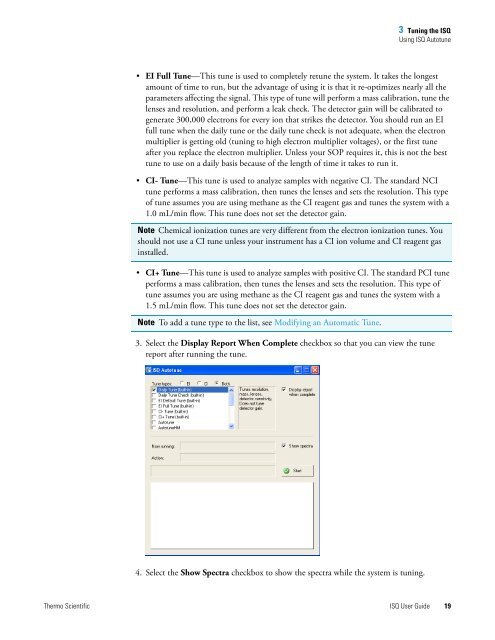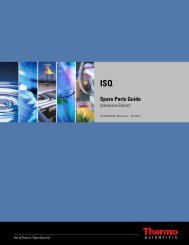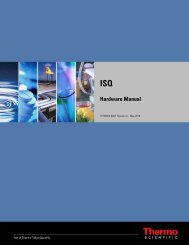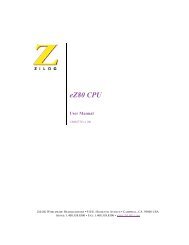ISQ User Guide - Write Frame of Mind
ISQ User Guide - Write Frame of Mind
ISQ User Guide - Write Frame of Mind
You also want an ePaper? Increase the reach of your titles
YUMPU automatically turns print PDFs into web optimized ePapers that Google loves.
3 Tuning the <strong>ISQ</strong><br />
Using <strong>ISQ</strong> Autotune<br />
• EI Full Tune—This tune is used to completely retune the system. It takes the longest<br />
amount <strong>of</strong> time to run, but the advantage <strong>of</strong> using it is that it re-optimizes nearly all the<br />
parameters affecting the signal. This type <strong>of</strong> tune will perform a mass calibration, tune the<br />
lenses and resolution, and perform a leak check. The detector gain will be calibrated to<br />
generate 300,000 electrons for every ion that strikes the detector. You should run an EI<br />
full tune when the daily tune or the daily tune check is not adequate, when the electron<br />
multiplier is getting old (tuning to high electron multiplier voltages), or the first tune<br />
after you replace the electron multiplier. Unless your SOP requires it, this is not the best<br />
tune to use on a daily basis because <strong>of</strong> the length <strong>of</strong> time it takes to run it.<br />
• CI- Tune—This tune is used to analyze samples with negative CI. The standard NCI<br />
tune performs a mass calibration, then tunes the lenses and sets the resolution. This type<br />
<strong>of</strong> tune assumes you are using methane as the CI reagent gas and tunes the system with a<br />
1.0 mL/min flow. This tune does not set the detector gain.<br />
Note Chemical ionization tunes are very different from the electron ionization tunes. You<br />
should not use a CI tune unless your instrument has a CI ion volume and CI reagent gas<br />
installed.<br />
• CI+ Tune—This tune is used to analyze samples with positive CI. The standard PCI tune<br />
performs a mass calibration, then tunes the lenses and sets the resolution. This type <strong>of</strong><br />
tune assumes you are using methane as the CI reagent gas and tunes the system with a<br />
1.5 mL/min flow. This tune does not set the detector gain.<br />
Note To add a tune type to the list, see Modifying an Automatic Tune.<br />
3. Select the Display Report When Complete checkbox so that you can view the tune<br />
report after running the tune.<br />
4. Select the Show Spectra checkbox to show the spectra while the system is tuning.<br />
Thermo Scientific <strong>ISQ</strong> <strong>User</strong> <strong>Guide</strong> 19






